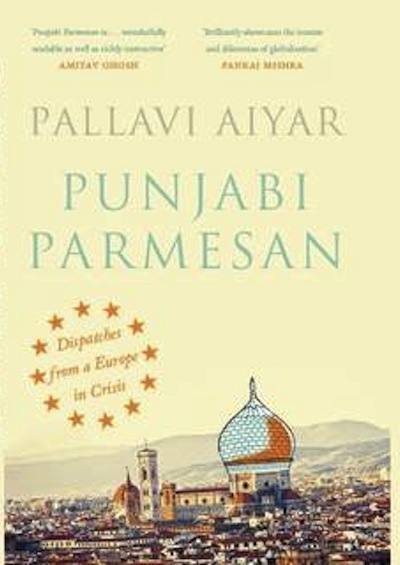India as an Inspiration for Europe?
What can India teach the EU regarding the key challenges it faces?
May 18, 2014

Polyphonic and pluralistic, as the world’s two most populous democracies, India and the European Union are animals of a remarkably similar temperament. Yet, they lead largely parallel lives. Their bilateral engagement is peripheral at best.
EU officials often blame this state of affairs on India’s foreign policy, which emphasizes the country’s sovereignty, as well as its lack of willingness to accept any form of cross-border governance.
What is rarely acknowledged is how in some ways, India is a proto-European Union. It has managed to stitch together a large region of diverse social and cultural fabric into a political and economic union.
Like today’s EU, India is the antithesis of the concept of the 19th century European nation state. Back then, a single religion, a single language and a common enemy were thought to form the “natural” basis for the only sustainable kind of political unit.
India, however, privileges no particular religion, does not enforce a common language (there are over 20 official Indian languages) – and, unlike many other nations in the region, does not promote a national identity by demonizing a common external (or internal) enemy.
As the Indian historian Ramachandra Guha points out, when measured against 19th century European parameters of the ideal nation state, it is Pakistan, rather than India, that should count as a success. After all, Pakistan is an Urdu-speaking, Muslim state, clearly defined in opposition to India.
India shows the way
India, on the other hand, has defied the exclusions and divisions of this ideal over the course of its 60-plus years as an independent nation. It is a testament to the fact that it is possible to successfully create a strong, common identity out of seemingly fractured multiplicity.
Were the European Union to care enough to look, India could serve as hope, if not guide, for the EU’s own momentous project. After all, Europeans have long struggled with just how to reject the homogenizing tyranny of the “nation” state — and instead choose to celebrate difference and aggregation.
This issue of a proper mix of a national and a European identity is very much at the center of the debate in the elections to the European Parliament. There, the issues are varyingly framed as “Is Brussels too overbearing?” or “Do we need to insist on more national sovereignty?”
Of course, either variant of this question may in fact be an indication of the profound nervousness across Europe that the deeper integration of the global economy engenders.
European arrogance
But, with characteristic arrogance, the EU does not really care to look elsewhere for inspiration. And it is most certainly not inclined to cast an eye in this regard towards dirty, poor, teeming India.
Instead, EU officials prefer to look at the world from a narrow, familiar perspective. They rarely even consider that ideas about statecraft might not only flow outwards from Europe to the “developing” parts of the world, but in reverse as well.
They shake their heads in collective despair over India’s reluctance to take a feather out of Europe’s cap on issues of regional integration. India’s ham-handedness in its dealings with SAARC (the South Asian Association for Regional Cooperation) are the classic case in point that they raise.
And while there cannot be any doubt that India can learn much about the mechanics of regional integration from the EU, this does not preclude Europe from having something to learn from India as well.
I believe that, by its very existence against the odds of modern political convention, India has something to teach Europe.
In India, the denominations of currency notes are listed in 17 languages, and almost all Indians are multilingual. The diversity that citizens negotiate on a daily basis is moreover, scarcely confined to the linguistic.
We are a country of hirsute Sikhs and smooth-skinned Tamils, of fish-eating Bengalis and vegetarian Gujaratis.
In our “Hindu” country, there are almost as many Muslims as in all of Pakistan. With no single language, ethnicity, religion or cuisine, the complexity of India is comparable to that of the EU.
We should give hope to the EU as it struggles with the possibility of balancing restricted national loyalties and identities, with the more capacious and amorphous civilizational identity and loyalty to Europe.
Cultural chauvinism in the 21st century?
I am well aware of the fact that South Asia remains poor and underdeveloped. And, no doubt, revitalizing regional trade and economic links between the countries of the region via SAARC, as the EU is always quick to point out, could potentially have dramatic benefits for Nepal, Sri Lanka, Bhutan, Bangladesh and the other member nations.
For all the inspiration that Europe can, and should, derive from India, it also provides many learnings for South Asia.
If countries like Germany and France have found a way of overcoming their blood-soaked history, it is proof that historical enmity does not have to preclude cooperation ad infinitum. Economic imperatives and statesmanship can enable a break from beggar-thy-neighbor mentalities and damaging patterns of behavior.
The EU is such a powerful idea. It represents a potentially renewed world, cognizant of its past sins, yet cleansed of them.
It foreshadows a brave new order where states find strength in ditching their primordial, tribal identities and opening up once insular borders to outside influences. In short, a post-war, post-national mosaic of composite multicultural identities.
So far the EU has failed to foster a strong, common European identity. That would require a robust, reflexive, loyalty to something larger than one’s parochial familiar surroundings.
Yet, I believe it is possible for a European identity to emerge. As an Indian, I seem to believe in this possibility with greater conviction than many Europeans.
Editor’s note: This essay is adapted from “Punjabi Parmesan: Dispatches from a Europe in Crisis by Pallavi Aiyar (Penguin Books India, 2013). Reprinted by arrangement with the author.”
Takeaways
By its very existence against the odds of modern political convention, India has something to teach Europe.
India does not promote a national identity by demonizing a common external (or internal) enemy.
India shows that it is possible to create a strong, common identity out of seemingly fractured multiplicity.
Were the European Union to look, India could serve as hope, if not guide, for the EU’s own momentous project.
In India, the denominations of currency notes are listed in 17 languages and almost all Indians are multilingual.
With no single language, ethnicity, religion or cuisine, the complexity of India is comparable to that of the EU.
Read previous

Al Capone of the Yoga Mat
May 17, 2014
